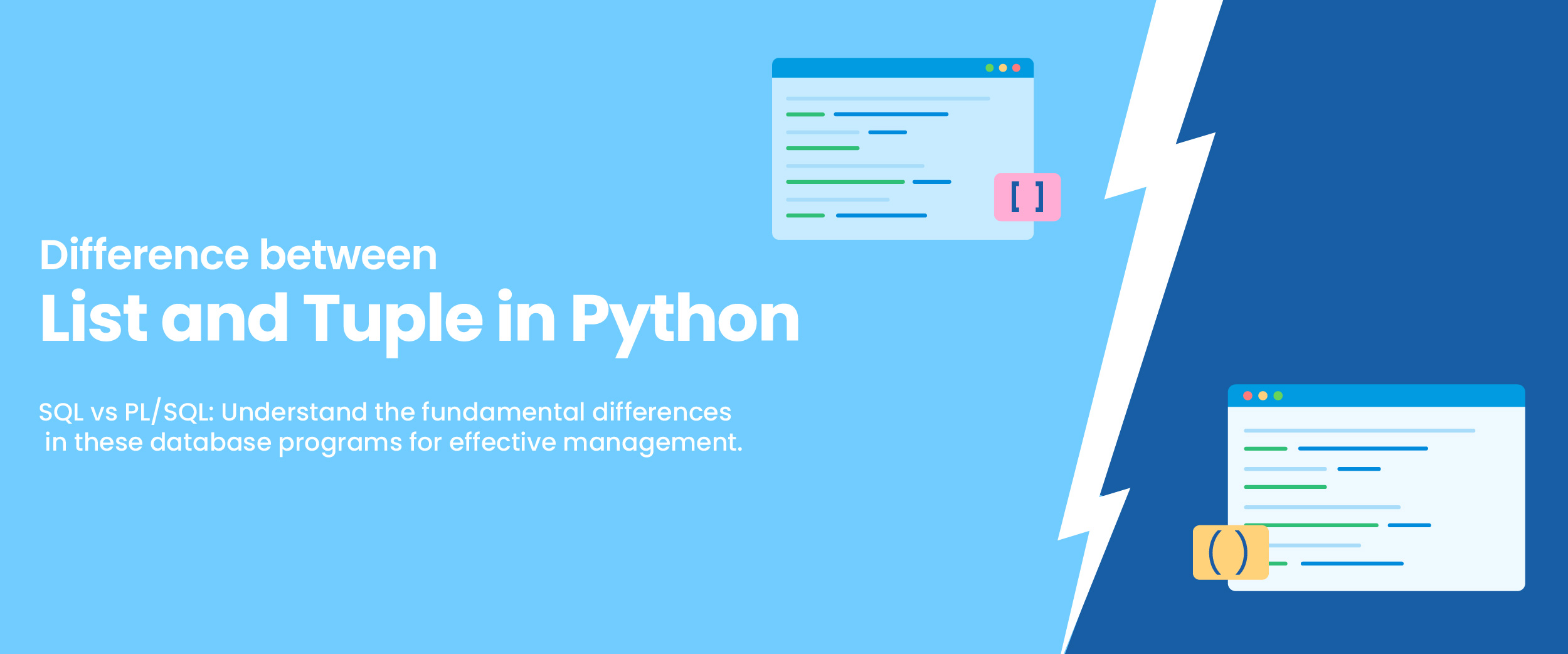List Vs Tuple: Difference Between List and Tuple in Python
According to studies, Python is the most rapidly growing programming language with a growth rate of 15.4%. It is the preferred option for many developers because of its versatility and usability.
The data types used in Python programming are one of its core features. The two most used data types are List and Tuple. Python developers must understand data types since they provide the foundation for how data is saved, handled, and processed in Python. In this blog, we will learn about the differences between a list and a tuple in Python. We will also look at which one stands better in the battle of Lists vs Tuples.
What is a List in Python?
A list in Python is a built-in data structure used to store a collection of items. It is an ordered and mutable collection of items, which means it can contain components of various types (such as integers, floats, strings, or other objects) and its contents can be changed by adding, removing, or modifying elements.
Lists can also include elements of several data types, including those from other lists. Because of this, they are incredibly versatile and helpful for a range of programming tasks.
What is Tuple in Python?
A tuple is a data structure in Python similar to a list but different in one crucial respect. Tuples are immutable, meaning that once they are created, their contents cannot be altered.
Tuples can be accessed via indexing and slicing because they are ordered, which implies that the order of the items in the tuple is maintained. Despite having fewer built-in options than lists, tuples are frequently used in circumstances where immutability is desirable, such as when representing data that should not be modified or passing it to a function that should not modify it.
To understand more about list and tuple in Python and how to best use it, you can pursue a Python programming course.
Difference Between List and Tuple in Python
Here are the key differences between a list and a tuple.
| Difference | List | Tuple |
|---|---|---|
| Mutability | Lists are mutable – element changes are possible | Tuple is immutable – elements cannot be changed |
| Performance | Slower because they are mutable | Faster due to being immutable |
| Usage | Used for collection of homogeneous items | Used for the collection of heterogeneous items |
| Syntax | Defined by square brackets ‘[ ]’ | Defined by parentheses ‘( )’ |
| Example | My list = [1,2,3,4,5] | My tuple = (1, fruit, true) |
Let’s explore these differences in detail –
1. Mutability
The key differentiator between a list and a tuple is that lists are mutable, whereas tuples are immutable, which means that once a tuple is created, its contents cannot be altered. Nonetheless, a new tuple with different contents can be created.
Lists, on the other hand, let you make changes to the items after it has been made. You can add, remove, or change items even after creation. Some of the available options are –
- To add, use append (). The items get added at the end of the list.
- To remove, use remove ().
- To add multiple items, use extend ().
- To add an element at a given position, use insert ().
- To remove an element from any position, use pop ().
- To sort the list in ascending order, use sort ().
- To clear the elements, use clear ().
- Len () returns the length of the list.
- Min () returns the minimum value in a list.
- Max () returns the maximum value in a list.
Some operations available in tuples are min (), max (), len (), and del ().
2. Performance
Tuples are often faster and require less memory than lists since they are immutable and cannot be changed. This is because modifying a tuple does not require Python to create a new memory. Tuples can also be used as dictionary keys, although lists cannot.
Lists, however, might be a better option if you frequently need to change the collection’s contents. This is so that a new tuple with the updated contents can be created each time a tuple is modified.
3. Usage
Lists are used to store homogeneous items. For instance, a list would be a good option if you wanted to store a list of numbers. The ability to add, remove, or rearrange the elements of a collection is another advantage of lists.
Tuples are used to store heterogeneous items. For example, a tuple would be a suitable option, if you wanted to store a person’s name, age, and profession. If the contents of the collection remain unchanged, tuples are a good option.
4. Syntax
The syntax of lists and tuples is the key difference between them. Tuples are defined using parentheses, whereas lists are defined using square brackets. For Example –
- Defining a list
my_list = [1, 2, 3, 4]
- Defining a tuple
my_tuple = (1, 2, 3, 4)
Also Read: Python Projects With Source Code
List vs Tuple in Python: Which is Better?
Choosing between a list or a tuple depends on the specific use case and what is the functionality to be achieved.
Here are some instances where using lists might be preferable:
- When you need to change the elements: As lists are mutable, you can change, add, or remove elements after the list has been generated. Lists are therefore a smart choice for working with dynamic data which might change over time.
- When sorting and searching activities are required: The sort() and index() methods, among others, are built-in tools for sorting and searching entries in lists. These techniques make it simple to interact with big data sets and complete tasks like finding the highest or lowest value in a list.
- When you need to store homogenous data: Lists help store homogenous data since they contain elements of various sorts. They might be a better alternative due to their versatility if you need to store homogeneous data, such as a list of integers or texts.
Here are some instances where using tuples might be preferable:
- When you need to store immutable data: As tuples are immutable, their values cannot be modified after they are generated. Tuples are a suitable option when you need to store information that shouldn’t be changed, such as constants or configuration options.
- When you need to work with heterogeneous data: Tuples are preferable for storing heterogeneous data like a list of integers or texts. Because of their fixed structure, tuples might be a preferable option if you need to work with diverse data, such as a tuple containing a mixture of strings, integers, and floats.
- When you need to return multiple values from a function: You can use a tuple when you need to return more than one value from a function without requiring a complicated data structure.
Conclusion
Both lists and tuples are significant data structures in Python, but they differ in certain important ways that make them more appropriate for particular tasks. You can choose the best data structure for your requirements and create Python code that is more effective and efficient by going through this blog on the difference between a list and a tuple in Python.
FAQs
Tuples work faster and more efficiently than lists and guarantee that any unintentional modification won’t happen. If there is data in a program that must remain unchanged, it’s best to store it as a tuple instead of keeping it in list form.
The list is mutable, which means it is possible to modify elements in a list. Individual items in a list can be altered by directly referencing them within an assignment statement.
One of the major advantages of the list over a tuple is that lists are mutable. This implies that it’s not possible to alter a tuple once created, unlike a list that can easily have elements added or removed from it. Also, lists are better when it comes to performing operations like insert, delete, etc.
Creating a tuple is quicker than creating a list because only one memory block needs to be accessed.






